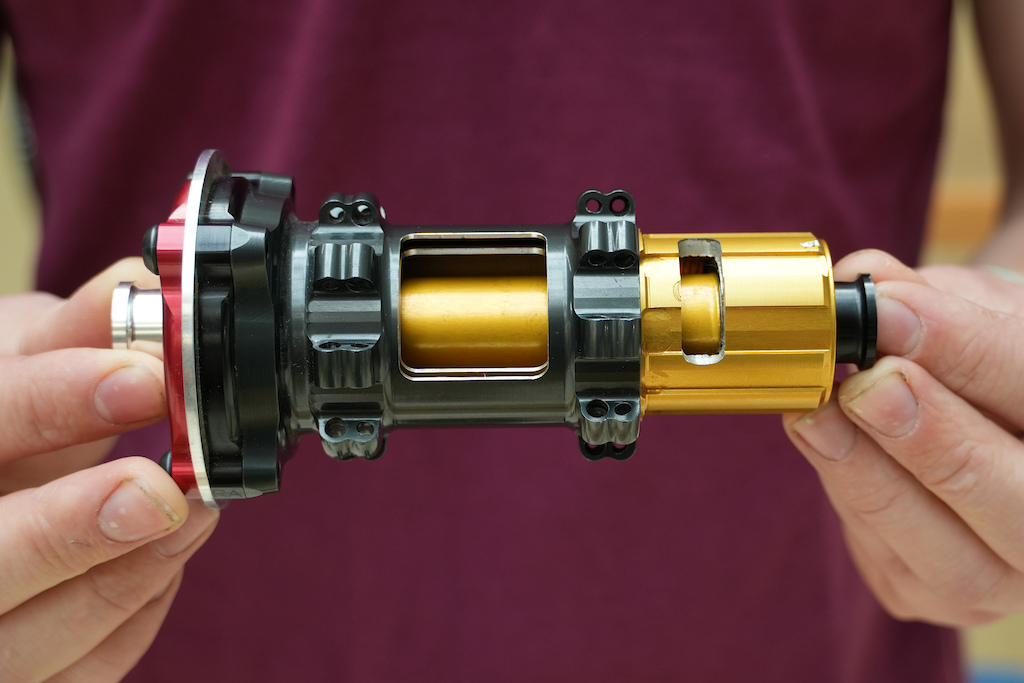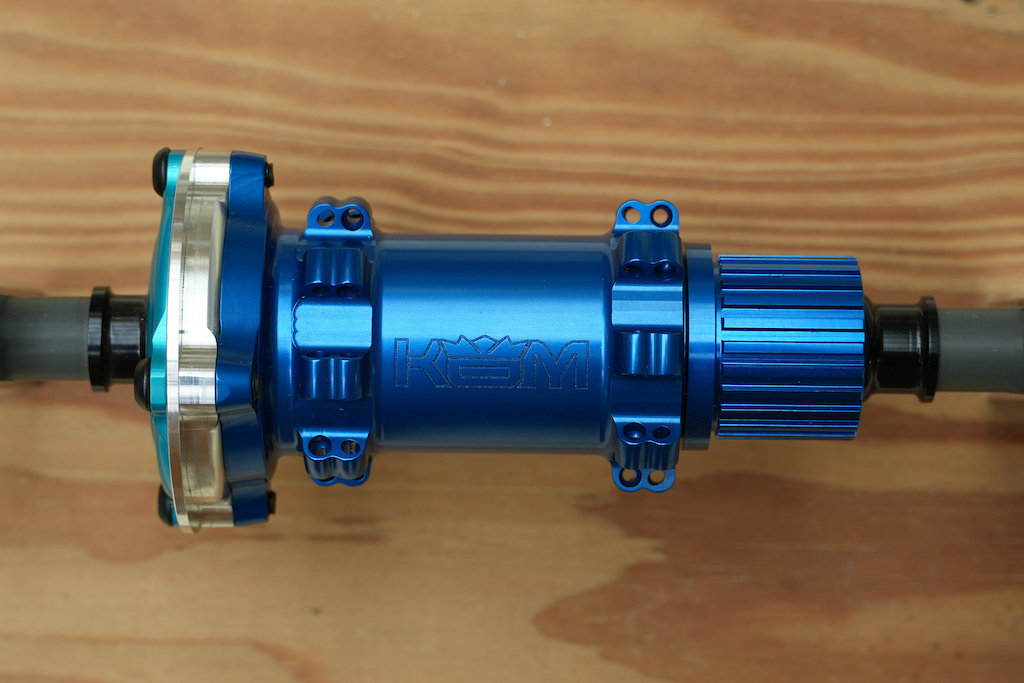First Look: KOM Xeno Infinity Drive Hubs Push from the Disc Side

The KOM Xeno Hubs put the freehub mechanism on the disc side, with the axle bearings sitting further apart from one another, reducing the bending moment on the axle
King of the Mountain, have completely redesigned the bicycle hub to switch the drive ring to the disc side. Why? To improve stiffness and load capacity for a longer service life.
KOM Founder, Steve Elkins, has been working away on the Infinity Drive design for 10 years, and now has a patent pending on it. Out of their Peak District HQ, KOM have been producing the Xeno Hubs for around 2 years, manufacturing every component, save for the bearings and pawls, in house. Steve's son, Leo Elkins, gave us a run down on the construction and layout at the Bespoked Show in Manchester, talking through the advantages of the design.
KOM Founder, Steve Elkins, has been working away on the Infinity Drive design for 10 years, and now has a patent pending on it. Out of their Peak District HQ, KOM have been producing the Xeno Hubs for around 2 years, manufacturing every component, save for the bearings and pawls, in house. Steve's son, Leo Elkins, gave us a run down on the construction and layout at the Bespoked Show in Manchester, talking through the advantages of the design.
KOM Xeno Hub Details
• 3° engagement (120 POEs)
• Performance claims: Reduced drag, longer bearing life, stronger axle
• Straight-pull spokes only
• Only compatible with KOM proprietary disc rotors
• Available with all major freehub and axle standards
• Price: from £550 (rear) / £275 (front)
• Lifetime Warranty on Axles and Hub Shell
• More information: k-o-m.co.uk
• 3° engagement (120 POEs)
• Performance claims: Reduced drag, longer bearing life, stronger axle
• Straight-pull spokes only
• Only compatible with KOM proprietary disc rotors
• Available with all major freehub and axle standards
• Price: from £550 (rear) / £275 (front)
• Lifetime Warranty on Axles and Hub Shell
• More information: k-o-m.co.uk

Placing the drive mechanism on the disc side allows for a much larger diameter ratchet. Claimed weight for the Standard spacing rear hub with XD drive is 260 grams.
Construction
Broadly speaking, most hub designs run the hub shell on two bearings, with a freehub body slid onto the drive side end spinning on one (sometimes two) bearing(s). The main hub shell bearing (the one taking the rider's weight) normally situates near the center of the hub's axle, placing the majority of the load right where leverage is at its greatest. When the system is under big loads (landing, cornering, etc.) the axle can be forced to bend slightly, causing momentary bearing misalignment. Such misalignment introduces drag, and also puts the bearings under greater stress and thus leaves them liable to wear. This layout is nigh-on ubiquitous, and many hubs from well-known manufacturers (Hope, Industry Nine, DT Swiss) rely on it.
King of the Mountain are of the opinion that the Xeno Hub's Infinity Drive layout is a more refined solution, claiming it delivers a stronger hub that is able to cope with greater loads, with the stiffer design delivering prolonged bearing life as a result. Central to the increased stiffness are the two concentric axles that the hub shell spins on. Their bearings are arranged in such a way that pedaling forces are more evenly distributed across the hub shell. The larger outer axle plays the role of transferring pedaling forces across the hub shell, with the inner axle playing the usual role of supporting the hub shell on the thru-axle.

The main hub axle that sits on the thru-axle. On the MTB hubs, there are actually two bearings that sit underneath the cassette holder on the drive side. Placing the bearings very close to the either end minimizes the bending moment across the axle, minimizing flex and resulting bearing misalignment.
The KOM hubs still use a basic spring-backed pawl and ratchet system to transfer drive forces to the hub shell, but it's situated on the disc side of the hub. The (would-be) freehub body on the drive side is simply a cassette holder. It threads into the larger outer axle of the hub body, the non-drive side of which houses the six triple-stepped pawls that interface with the 60t drive ring. Only three of the six pawls interface with the teeth of the ratchet; that gives 120 POEs and a resulting engagement angle of 3°.
Spacing the inner axle's bearings apart, with one situated at each end of the axle, is said to better manage the forces across the hub to reduce the bending moment and resulting bearing misalignment. The whole assembly is supported across the hub's full width. The main claimed advantage is that the bearings last much, much longer. The other major one is that the axle is at a significantly reduced risk of breaking because of the improved load distribution. KOM say these advantages are relevant for all bikes, but the design is particularly well suited to use on eMTBs where the torque translated through the hub is consistently higher.
The aluminum drive ring is actually pressed into a proprietary steel disc rotor. Leo tells us that this configuration allows the steel disc rotor to increase the strength of the drive ratchet by allowing the rotor to take on the radial forces produced at the drive ring. As the aluminum ring starts expanding under high torque, the steel takes on the load. Braking forces are isolated from the drive mechanism, as the rotor itself is bolted directly to the hub shell.
But, we've just glossed over a drawback of the KOM hubs. They are compatible only with KOM's own disc rotors. The production of these is outsourced to a company in Europe. They are available in all standard sizes from 160mm up to 223mm, and all are 2mm thick. A 2.3mm option with also be available soon for diameters of 200mm and upwards; the 223mm x 2.3mm rotor weighs a claimed 234 grams. All retail at £50.
Looking at each pair of bearings in the KOM Xeno hub, the drive-side one is fixed in its position while the non-drive side one is "floating" - there is no spacer in the way so its position can shift ever so slightly laterally along the axle. This effectively means that when you tighten your thru-axle, compressing everything together, the non-drive side bearing is free to move axially such that it isn't overly pre-loaded in the process.
Pricing & Availability
The KOM Xeno Infinity Drive hubs are available in Standard, Boost and Super Boost spacing with Thru-Axle and QR variations to accommodate Road, Gravel and MTB. Spoke counts can vary from 24 up to 32, dependent on the intended application. Pricing starts from £550 for the rear hub and £275 for the front.
Author Info:
Must Read This Week
Sign Up for the Pinkbike Newsletter - All the Biggest, Most Interesting Stories in your Inbox
PB Newsletter Signup









It’s a laser/waterjet cut piece of steel with no/minimal post processing.
Not mentioned in the article is that these rotors are really really good. Only rotor I've ever had that hasn't warped and had an annoying rub.
But no one is running discs made by them. Why wouldn't they if they are so easy to make?
KOM say there is soon to be at least one brake disc company offering this disc type fitting for sale in Europe. Steve from KOM said, "We just want to make sure they make the discs right, so they work well. KOM discs are far more warp resistant than most and the extra strength of the steel in the disc is also used to reinforce the ratchet area of the hub...so they need to be right."
It’s only bad proprietary until it’s industry standard*.
Generic formula hubs last years without service, then dt/hope/whatever brand - last more then u keep the frame.
Why would u want something that complex to prolong 20$ bearing life for 1 year?
I’m replacing hub bearings every 6 months ish. Hope pro 4 and generic formulas included
I think hubs are luck of the draw. I now remember a SRAM front hub that had no grease from factory, screwed itself within 3 weeks. I've heard people being too strong for Hopes, and Chris King ceramics not lasting.
Another random thought I had, we always use sealed bearings in MTB hubs. Those seals aren't for water are they? They're probably great for dust, but maybe they're trapping water in? That lays blame to the hub design.
Who knows, try some DT350s everyone seems to love them.
DT350's are great hubs. But if high engagement is important to someone, they are not realistically an option.
You can get end caps for almost any axle spacing.
I’m not gonna get my 197 fat bike hub on a 135 rear.
But I know my almost ten year old 142 hub will be rebuilt for my next bike.
BTW I’m almost 300 lbs and have done very little to my hubs.
Run a 350 hub at that engagement, they chew the ratchets up. This is exactly why DT is trying again, with the 240 DEG hub.
10* engagement is realistically the highest engagement you can reliably run on a 350 hub.
Stiffererer.
cdn11.bigcommerce.com/s-dkttq6iuv8/images/stencil/1024x1024/products/1691/6561/180-HUB-Evolution-Axle__52738.1579719888.png?c=2
This hub moves the weight loaded bearings close to the dropout for maximum stiffness and strength.
So I really like the idea of moving the right side bearing closer to the frame but the proprietary rotor is not great...
www.pinkbike.com/news/patent-revels-how-ethirteens-anti-pedal-kickback-sidekick-hub-works.html
And if you do this, the non-drive-side shell diameter could grow and then there's plenty of room for things like non-drive-side hub internal power meters and drive rings.
Right now you have a small diameter for the hub and then a bunch of material to get to the 180, 200, or 220mm diameter of the rotor. In every situation where a manufacturer tries to save weight, they don’t go with small tubes and lots of material. It’s always larger diameter which means more strength, and thin tubing which is less weight. A bigger hollow hub with ice tech style spider arms cast in is not heavier.
And the only weight that is moving out from the center vs an ice tech rotor is that the bolts go in the position where rivets would be. That’s such a tiny change that I can’t believe it would be a point of contention.
If this wasn’t the optimum setup for strength and weight, we wouldn’t have crank spiders with a relatively large bcd. We have direct mount cranks for versatility and because we don’t put large cogs as part of a triple on a mtb anymore. I argue that the creators of the 6 bolt standard never saw rotors growing to their current size, and they would have had crank style arms from the start if they did.
Glad to see these come to market! Thumbs up to 2.0 & 2.3mm rotors
If you've broken multiple 190/197mm hubs, then you know what I'm talking about.
For $600+, straight pull spokes and proprietary rotor....that's a hard no, sadly. I'd be much more open to it if I could run a regular rotor.
Just on a side note I myself do not suffer with hub reliabilty problems. I’ve switched to Hope a long time ago (since pro 2s) and never looked back. Never had problems with those (the pro 2 is still going strong on the 26er).
However, I’ve just had a rear wheel built with one of these hubs. I am a big guy, 120kgs, 195cm, and have broken every rear hub I have ever used (inc DT swiss and Hope). Some last 1000kms, some 250kms. It is either axle shearing or freehub/pawl/ratchet disintegration. Most seem to be caused by flex as very well described here (www.youtube.com/watch?v=qO6DUSKhbRU), and is on full sus, hardtail and now with even greater frequency on an eeb.
The one hub that now does not break, is a Hope Pro 4 for which a friend machined for me a solid stainless steel axle with M8 bolts.
Unfortunately this is a problematic solution for my eeb which has a UDH, so I’ve decided to give KOM a try. (Interestingly, I talked to Chris King and they were not keen on suggesting their hubs would be any better, and i9 etc seem to be solving no issues but costing a fortune)
Now about 250kms in, the hub so far seems fine. ratchet is V noisy. The disc is indeed nice and consistent. Currently in the alps for a long weekend, let’s see how well the hub lasts. Fingers crossed!
To be fair I ride 32 hole rims, maybe it's more of an issue on lower spoke count hubs/rims.
Also, 350 hubs have set a hell of a bar for any hub with any layout to match.
steel HG freehubs, hub end spacers to suit vatious axle lengths, diameters and I can choose which
disc rotor, J bend spokes just work, choice of colours and depending what I go for a cost that suits.
Been around for ages stood the test of time, so until all that can be matched no need for me to change,
will just watch from a distance and see what becomes of this new stuff : )
The discs are the best I've ever used and the ONLY disc I've ever had that hasn't warped and then had an annoying rub.
m.youtube.com/watch?v=qO6DUSKhbRU
www.youtube.com/watch?v=qO6DUSKhbRU&t=40s